| THE ATMOSPHERE AND WEATHER OF MARS | ||||||||||||||||||||||||||
| The length of the Martian day, the tilt of the planet's axis and the chemistry of the Martian atmosphere should result in an atmosphere similar to Earth's. However, the two planets differ significantly causing the Martian atmosphere to behave differently. | ||||||||||||||||||||||||||
| On Earth, the oceans transport large amounts of heat through ocean circulation and water evaporation. Mars has no oceans - therefore this mechanism for transporting and conserving heat is not available. | ||||||||||||||||||||||||||
| Atmospheric composition | ||||||||||||||||||||||||||
| On Earth, carbon dioxide is a rare gas making up only 0.025% of our atmosphere, whereas on Mars virtually the whole atmosphere is carbon dioxide; a "greenhouse" gas. The remainder of the Martian atmosphere is made up mostly of nitrogen and argon. A substantial proportion of the Martian atmosphere freezes during the Martian winter and drops onto the surface as a polar cap. With a large part of the atmosphere missing for many months, the behaviour of the atmosphere changes significantly. | ||||||||||||||||||||||||||
| As well as the normal seasonal effects caused by the tilt of the rotation axis, the eccentricity of the Martian orbit generates an additional seasonal effect. At perihelion, Mars is 43 million kilometres closer to the Sun than at aphelion. The increased solar energy pouring onto Mars at perihelion (and the opposite reduction at aphelion) causes seasonal heating and cooling across the entire planet. | ||||||||||||||||||||||||||
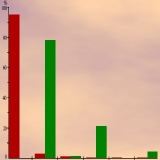 Atmospheric composition |
 Atmospheric composition |
|||||||||||||||||||||||||
| Pressure | ||||||||||||||||||||||||||
| Martian air is very thin. The average atmospheric pressure at the surface of Mars is 7 millibars (mb) compared with 1014mb on Earth. In the deep basins of Mars, where there is a taller column of air pressing down, the pressure rises to 9mb. The pressure at the top of Olympus Mons is only 1mb. The pressure at the surface, measured by the two Viking Landers, shows a seasonal variation of about 20%. This is caused by the planet-wide effect of the atmosphere freezing in the south polar regions during the long dark winter. | ||||||||||||||||||||||||||
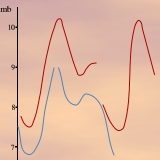 Atmospheric pressure. |
||||||||||||||||||||||||||
| Weather and Seasons | ||||||||||||||||||||||||||
| On a hot Martian summer's day the temperature manages to climb to 20oC - a comfortable room temperature on Earth. But in the depths of a Martian winter temperatures plummet to -140oC , cold enough to freeze the atmosphere itself. Carbon dioxide gas freezes out of the atmosphere and forms a polar cap that evaporates back into the atmosphere during the spring. Nowhere on Earth do temperatures get so low as to freeze air. | ||||||||||||||||||||||||||
| Atmosphere and temperature | ||||||||||||||||||||||||||
| On Mars because there are no oceans, the circulation of the atmosphere is governed by the temperature difference between the summer hemisphere and the winter hemisphere. Warm air tends to rise over the warm summer hemisphere, crosses the planet's equator, and descends towards the colder winter hemisphere. The winter hemisphere is where the carbon dioxide is frozen out of the atmosphere, creating a lower pressure. Just as on Earth, the atmosphere will tend to flow towards regions of low pressure. | ||||||||||||||||||||||||||
| Cyclones | ||||||||||||||||||||||||||
| There are some similarities between Earth and Mars. Planetary rotation causes north-south air movement to be deflected into the east-west direction. On each planet, this sets up cyclones and anti-cyclones; the most severe cases on Earth are hurricanes. On Mars also cyclones and anti-cyclones wander across the planet. The diameter of the cyclone weather system is approximately 400 kilometres. | ||||||||||||||||||||||||||
| Thermal winds | ||||||||||||||||||||||||||
| During the day on Earth, the land warms up faster than the sea and warm air rises over the land. This lowers the air pressure over the land, and cooler air then blows in from the sea. At night, the land cools more quickly than the sea and the wind is reversed and blows out to sea. | ||||||||||||||||||||||||||
| A similar process occurs on Mars. Although there is no ocean, there is a very rapidly cooling land surface. The thin atmosphere allows the Martian surface to lose its heat far more quickly. Once the Sun has set, the temperature difference between night time land and nearby daytime land sets up thermal winds. These thermal winds then chase the sunset across the planet. Earth's atmosphere is a thousand times thicker than Mars', preventing such large temperature differences between day and night. Consequently Earth's "thermal tide" is much smaller. This effect should be compared with Venus, where the thermal tide effect is so strong it has affected the rotation of the planet itself. | ||||||||||||||||||||||||||
| Devils and storms | ||||||||||||||||||||||||||
| Although Martian air is thin, it is still capable of kicking up dust as it blows across the land. When wind speeds start to reach 50 to 100 metres per second, very small grains of sand start to skip along the surface, raising dust each time they land. This process is called saltation, and occurs on Earth, for example in the Sahara Desert. The dust raised into the Martian atmosphere can take many months to descend back to the ground. | ||||||||||||||||||||||||||
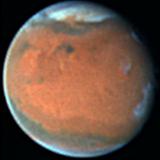 This image, captured on the 18th September 1996, shows a 1000 kilometres wide dust storm crossing the edge of the northern polar cap. |
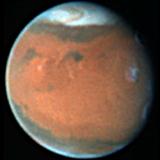 This image, taken a month later on 15th October, shows another dust storm over the polar cap. The cap has shrunk between the two observations, and the edge of the cap has moved northwards a further 120 kilometres |
|||||||||||||||||||||||||
 A Viking Orbiter image of a dust storm over the Chryse Basin. Parts of the storm are moving at speeds up to 60 metres per second. |
 Image obtained by the Mars Global Surveyor spacecraft, shows the Viking Lander 1 landing site as seen from an altitude of 640 kilometres early in the Martian morning. Most of the area is obscured by a local dust storm. |
|||||||||||||||||||||||||
| Planet-wide storms | ||||||||||||||||||||||||||
| Earth and Mars both have winds capable of starting and maintaining dust storms. Here the similarity ends, for on Mars what starts as a small local dust storm can grow to become a huge storm that covers the planet. Earth does not suffer from planet wide dust storms because most soil is locked in place by vegetation. The entire surface of Mars is a source of dust; none of it is locked down by vegetation. There are many theories attempting to explain the rise and decay of the huge Martian dust storms. Some years there are no storms at all, other years see the planet covered with severe storms, and yet there appear to be no major differences in weather to trigger them. | ||||||||||||||||||||||||||
| Seasons on Mars | ||||||||||||||||||||||||||
| The distance between Mars and the Sun varies between 206.6 million kilometres at perihelion to 249.2 million kilometres at aphelion. Consequently the amount of sunlight falling on Mars changes significantly; Mars picks up 40% more heat from the Sun at perihelion than at aphelion. | ||||||||||||||||||||||||||
| As Mars swings round the Sun at perihelion it is also travelling at its fastest, and so picks up extra heat but for a shorter time. When Mars has reached the other side of its orbit, at aphelion, solar heating is not only lower, but Mars is travelling slower and then stays at a farther distance for longer.The combined effect is an imbalance between the seasons. | ||||||||||||||||||||||||||
| The table below shows this effect. The season is determined by the tilt of the axis. The hemisphere tilted towards the Sun is the summer hemisphere, the hemisphere tilted away is the winter hemisphere. The imbalance in seasonal length is caused by the varying distance from the Sun. | ||||||||||||||||||||||||||
|
||||||||||||||||||||||||||
| Re-arranging the table to compare the seasons shows why a southern winter is worse than a northern winter. During a southern winter the planet is farther away from the Sun, travelling slower, and all temperatures are reduced for longer. The orbital eccentricity explains why the southern polar cap grows to be larger than the northern cap. | ||||||||||||||||||||||||||
|
||||||||||||||||||||||||||
| Solar input | ||||||||||||||||||||||||||
| It is easy to see the effect eccentricity has on solar input. The map shows the maximum heating occurring at perihelion when the southern hemisphere is tipped towards the Sun. | ||||||||||||||||||||||||||
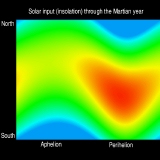 Solar input |
||||||||||||||||||||||||||
| Climate changes | ||||||||||||||||||||||||||
| The tilt of the axis at perihelion is currently towards the Sun, but this is not permanent. The axial tilt varies through a 100,000 year cycle, and in 25,000 years time the climate of the hemispheres will be reversed. The Martian orbit is also changing, because of the gravitational pull of the other planets, especially massive Jupiter. This too varies the seasonal performance of the atmosphere. Through millions of years, Mars has had a variety of climates - currently we see only one of those climates. | ||||||||||||||||||||||||||
| Dust devils | ||||||||||||||||||||||||||
| The two images below were captured by Mars Global Surveyor on 26th April 1998. Two long tracks can be seen - each track is about 40 metres wide. The tracks were probably left by dust devils. Dust devils, shaped like tornadoes, are spinning funnels of air that occur often in Earth's desert regions. Mariner 9, the Viking Landers and Orbiters, and Mars Pathfinder have all discovered signs of dust devils. Over 100 have been observed: 6kilometres high with diametres up to 1kilometre. | ||||||||||||||||||||||||||
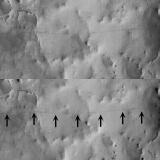 Dust devil track |
 Dust devil track |
|||||||||||||||||||||||||
| Martian sunsets | ||||||||||||||||||||||||||
| Sunsets on Mars show a variety of colours just as they do on Earth. The colouring depends on the effect of clouds as well as the volume of dust particles suspended in the atmosphere. | ||||||||||||||||||||||||||
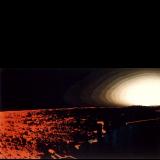 The image above was taken by Viking Lander 2. |
||||||||||||||||||||||||||
|
|
||||||||||||||||||||||||||